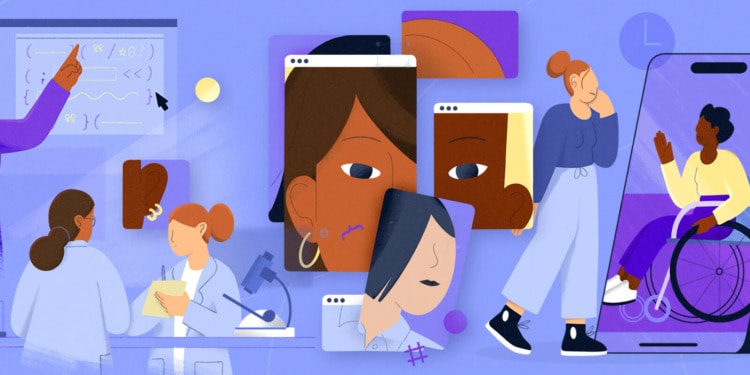From online learning and digital activism to the rapid expansion of high-paying tech jobs, the digital age has generated unprecedented opportunities for the empowerment of women and girls. But advancing technology is also introducing new forms of inequality and heightened threats to their rights and well-being.
Women and girls remain underrepresented across the creation, use and regulation of technology. They are less likely to use digital services or enter tech-related careers, and significantly more likely to face online harassment and violence. This limits not only their own digital empowerment but also the transformative potential of technology as a whole—over the past decade, women’s exclusion from the digital sphere has shaved $1 trillion off the GDP of low- and middle-income countries.
In the face of escalating global crises, we stand at a crossroads: allow technology to widen existing disparities and further concentrate power in the hands of the few, or put it to work on behalf of a safer, more sustainable, more equitable future for all.
The choices we make today will profoundly impact our path forward. Here are four steps we can take in the right direction.
1. Close all gaps in digital access and skills

As our daily lives become increasingly digitalized, gender gaps in digital access threaten to leave women and girls even further behind. Though efforts to close these gaps have led to improvements in the gender parity score, the absolute gap between men and women’s access has actually increased by 20 million since 2019. Today, 63% of women have access to the internet, compared to 69% of men. And women are 12% less likely to own a mobile phone, a figure virtually unchanged since before the pandemic.
These global averages don’t tell the whole story: race, age, disability, socioeconomic status and location all play a role in determining women’s digital access and use. Marginalized groups such as older women, rural women and women with disabilities face significantly greater barriers to connectivity. In the least developed countries—where, despite mobile broadband signals covering 76% of the population, only 25% is connected—men are 52% more likely to be within that online minority.
All of which makes clear that bridging access gaps will require more than just better digital infrastructure. Addressing factors like affordability, access to electricity, online privacy and safety, social norms and digital skills and literacy—all of which are mediated by gender—will be key to getting women meaningfully connected.
No one sector can do this alone: it will take collaboration between governments, businesses and civil society and women’s organizations, among others. Explicitly working gender and intersectional perspectives into digital plans and policies can help catalyze this kind of cross-sector coordination—a crucial starting point, given that only half of national information and communications technology (ICT) policies or master plans make any reference to gender today. Successful policy making will also require increased research on barriers to women’s digital access, as well as data collection on the efficacy of efforts to overcome them.
But knowing what works isn’t enough—governments need to invest in evidence-based programmes and initiatives. Subsidizing smartphones and laptops for women and girls and incentivizing the provision of low-cost data plans can go a long way in overcoming gendered access barriers. This also applies to digital literacy programmes, which can help give women and girls the skills they need to lead, connect and successfully shape the digital space.
2. Support women and girls in STEM

Today, women remain a minority in both STEM education and careers, representing only 28% of engineering graduates, 22% of artificial intelligence workers and less than one third of tech sector employees globally. Without equal representation in these fields, women’s participation in shaping technology, research, investments and policy will remain critically limited. The same challenges apply to their access to fast-growing and high-paying careers—an inequality compounded by the fact that, as tech and digital innovation disrupt industries, women will bear the brunt of job losses.
Stereotypes about who is, and isn’t, well suited to STEM play a major role in discouraging girls from entering these fields. These beliefs become a self-perpetuating cycle: without encouragement in tech fields, girls end up lacking necessary knowledge—thus making them less likely to express interest.
Those who do make it into tech often face an actively hostile environment, with a significant pay gap (21%) and considerably lower rates of promotion (52 women for every 100 men). Nearly half (48%) report experiencing workplace harassment. A whopping 22% say they are considering leaving the workforce altogether due to the treatment they’ve received in the sector.
Related Articles: How A Treaty to Improve Women’s Rights is Dividing the EU | European Parliament Votes to Enshrine Abortion in EU Charter of Fundamental Rights | Why Do So Many Companies Lack Women Leaders? | New Menstrual Leave and Abortion Laws in Spain: Are Reforms a Gain for Women?
Past efforts to increase women’s representation have often focused on women’s supposed disinterest in STEM fields, rather than on the systems that exclude them. That messaging has actually backfired, fueling the idea that women don’t have real interest or talent in STEM. Effective solutions must target both the barriers that force women out of STEM jobs and those that keep girls from pursuing them in the first place.
Providing universal broadband access for teachers, students and schools—and ensuring digital literacy for its users—can increase girls’ exposure to STEM, particularly those from less privileged backgrounds. Digital learning provides new opportunities to adapt educational environments and curricula to the needs of girls and students from marginalized groups.
Working to eliminate gender biases from schools is also key, as is ensuring that girls have access to women mentors in STEM fields with whom they can identify. And connecting STEM to other disciplines—as well as emphasizing its potential applications to societal challenges, which research shows is a main driver of girls’ career choices—can help increase girls’ interest as well.
To help women succeed in a changing labour market, targeted reskilling and upskilling programmes should be created, focusing especially on groups most in danger of being left behind. And expanded labour regulations are needed to ensure that labour market transitions improve the position of women, rather than simply reproducing existing inequalities. This includes a living minimum wage, regulations against pay discrimination, and social protection systems that address, for example, discrepancies between the unpaid care burdens of women and men.
3. Create tech that meets the needs of women and girls

Technology reflects its creators. So when women and girls are left out of tech and innovation spaces, it’s no surprise that digital tools fail to meet their needs. Severe underinvestment in, for example, digital tools that promote sexual and reproductive health is the natural outcome of decision-making processes that systematically exclude women’s voices.
At the same time, digital access gaps mean women produce less data than men, and a lack of data disaggregation leads to unequal representation in data sets. This has major downstream effects on machine learning and AI enabled service delivery. A global analysis of 133 AI systems from 1988 to today found that 44.2% displayed gender bias, with 25.7% exhibiting both gender and racial bias—which led to lower service quality, unequal resource distribution and the reinforcement of harmful stereotypes.
This problem has gone largely unchecked due to the inadequacy of tech sector oversight. Even where ethical frameworks have been developed, they lack safeguards—and since regulation has been largely left to companies themselves, many have ignored or underinvested in harm mitigation strategies.
Creating more inclusive, less biased tech starts with design and regulation processes rooted in human rights. That means centering the voices of marginalized and vulnerable women, as well as social and behavioral scientists and human rights experts, in the design of new digital tools. It also means explicitly addressing tensions between the exercise of different rights online, such as freedom of expression vs. right to safety. And it means making ethical frameworks enforceable by grounding them in international human rights standards and norms.
Regulatory reform can’t be left up to the tech sector. Governments need to step in to outline companies’ responsibilities, mandate monitoring mechanisms such as gender impact assessments, and ensure data use transparency through mechanisms like mandatory artificial intelligence audits. At the international level, digital governance will be crucial to ensuring that developing technology is aligned with the common good rather than just with the interests of multinational corporations.
4. Address technology-facilitated gender-based violence

Despite its prevalence and gravity, there is no universally accepted definition of technology-facilitated gender-based violence, but it can be understood as any act of violence committed, assisted or aggravated by the use of ICT on the basis of gender. Though such acts often take place in the virtual sphere, they result in tangible harm—physical, sexual, psychological, social, political and/or economic. This kind of violence doesn’t end when women log off: there’s a continuum between real-world and online violence, with technology helping to perpetuate and heighten surveillance, trafficking and other forms of abuse.
In the online sphere, gender-based violence also forces women and girls to self-censor and deplatform, limiting their ability to engage and participate virtually. As social media becomes an increasingly crucial space for both socializing and organizing, it has also become a key site of gendered disinformation, misinformation, sexist hate speech and more—all of which undermine women’s online expression and movement.
For women who face intersecting forms of discrimination, including women of color, women with disabilities and LGBTIQ+ people, the risk is even higher. Same with women in the public eye—journalists, politicians and women’s rights defenders, for example—who face significantly higher levels of hate speech and other violence than their male counterparts.
Beyond the lack of a formal definition, coherent global norms and standards on online-gender based violence do not exist. As tech generates new forms of violence—such as nonconsensual deepfakes—existing legal frameworks cease to apply. And online violence (like all forms of gender-based violence) is seriously underreported, with only 1 in 4 women reporting violent acts to the platform where they took place, and even fewer—14%—reporting to a protective agency.
All of which is to say, action is urgently needed. Expanded legal frameworks must be developed in coordination with women’s organizations and centered around human rights and survivor-informed approaches. Policy makers should coordinate with the justice sector, civil society organizations, the media and other sectors to develop coherent responses and strategies for mitigation. And design processes based in human rights can improve reporting and moderation systems, helping to take the onus off victims.
Finally, teaching digital citizenship can help cover issues of online violence—while also instilling empathy and ethical digital media use, and teaching boys and men to become advocates for gender equality.
— —
This article was originally published on the UN Women website, and is republished here as part of an editorial collaboration with UN Women.
Editor’s Note: The opinions expressed here by the authors are their own, not those of Impakter.com — Featured Photo Credit: UN Women.














